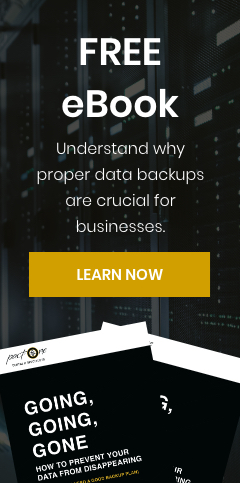Disaster recovery (DR) has undergone major changes for the better since cloud computing became popular. In particular, dental practices have benefitted from more cost-effective and reliable DR solutions. But there are still plenty of misconceptions about DR that are keeping many dental practice owners from adopting the right DR strategies. Here are three myths that no longer ring true.
Myth 1: Disaster Recovery is Expensive and Not Worth the Investment
Fact: DR solutions are not as expensive as they used to be. In the past, data recovery was a drawn-out process that could take days or even weeks and cost up to six figures. But with cloud and virtualization solutions, it’s now possible to back up data quickly and affordably. Outsourced DR providers, for instance, can now complete full backups in several hours and perform backup recovery processes in less than a day. Should you encounter a disaster, modern day DR solutions help keep your dental practice up and running, rather than incurring downtime.
Another fact: A sound disaster recovery strategy may require huge investments, but it’s’ worth it. Especially considering you need to protect patient data and comply with HIPAA. However much you spend on DR, it will still be much less than the price you’ll pay for a data loss incident. For one, the cost of losing data is simply too steep. According to IBM, a data breach costs on average $4.45 million in 2023. This price can shut down any dental practice.
Myth 2: All Disasters are Created Equal and Require the Same Response
Fact: Not all disasters are created equal. You will need a tailored response to the specific type of disaster that has occurred. For example, if your dental practice is impacted by a power outage, you will need to take different steps than if you were hit by a ransomware attack. Because of this, you should have a comprehensive DR strategy that covers all potential disasters (natural and man-made) that can befall your dental practice. Conducting a disaster risk assessment helps ensure that your practice is prepared to mitigate any catastrophe.
Here are just a few of the disasters that Pact-One has witnessed and helped clients solve with a proper BDR solution in place:
- A client’s server was compromised by a disgruntled employee, but with the Pact-One BDR in place, it became a physical server so the dental practice could remain up and running.
- A dental practice lost its office due to a fire. With the BDR and cloud-based storage, employees used unharmed computers to access files safely stored in the cloud.
Myth 3: Disaster Only Happens to Large Businesses, Not to Dental Practices
Fact: Disasters can happen to any business, no matter its size. In 2023 alone, there were 28 separate natural disasters that cost at least 1 billion dollars each (a historical year, but a consistent pattern due to exposure, vulnerability, and climate change). These events affected all kinds of businesses. Some businesses had to stop operations for weeks or months, while others were destroyed and closed for good.
Another Fact: Healthcare organizations, including dental practices, are targeted by cybercriminals due to their valuable patient data. There are instances of data breaches and cyberattacks occurring in both small dental practices and dental service organizations, such as the following:
- Small dental practice in Seattle, WA experienced a data breach that affected 2,281 patients
- Large dental service organization experienced a cyberattack that brought down their scheduling and phone systems, and other business applications
The bottom line is that no business is immune to natural or human-made disasters. Whether you’re a small dental practice or a dental service organization, it’s important to be prepared and have a comprehensive DR strategy in place. This can help you mitigate the damage caused by any type of disaster and ensure business continuity even in the face of adversity.
Conclusion
By learning the truth about these DR myths, we hope you’ll be encouraged to create a disaster recovery plan (DRP) for your dental practice. There’s no longer an excuse not to have one, as DR technologies are now more affordable and easier than ever to implement.
If you’re interested in learning more about our DR solutions and how they can help safeguard your data, contact us today. We’re here to help and happy to fill you in on all the details!
Dental IT. Remove the Burden. Embrace the Use.
Quality patient care – it's ultimately why you became a dental professional. But, some business operations can get in the way (such as pesky computer issues or lack of IT support). That’s where Pact-One Solutions can help! Our passion lies in supplying reliable, responsive dental IT support and security that practices can count on.
Whether you’re looking for dental IT services for your startup or searching for more responsive dental IT support – our team of dental IT specialists have you covered. With team members throughout the United States, we offer nationwide support to dental practices of all sizes. Our wide range of dental IT services ensure your data is secure, accessible, and protected.
Don't let technology challenges hinder your ability to deliver exceptional dental care. Contact us at info@pact-one.com or 866-722-8663 to join 350+ dental practices thriving with the support of a dedicated dental IT team.
Sources:
- IBM – Cost of a Data Breach Report 2023
- Climate.gov - 2023: A historical year of U.S. billion-dollar weather and climate disasters
- Washington State Office of the Attorney General – Data Breach Notifications
- U.S. Department of Health and Human Services Office for Civil Rights – Breach Report


